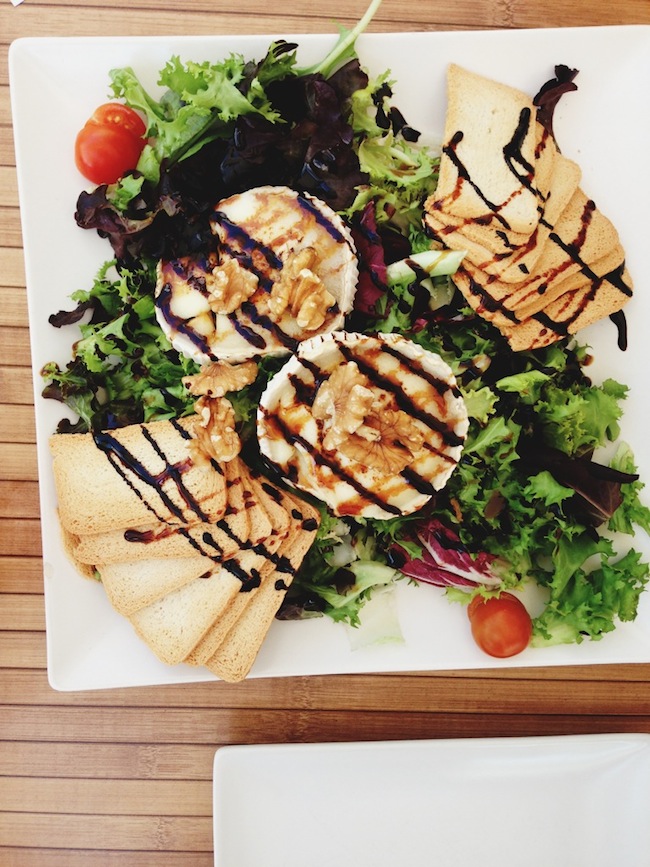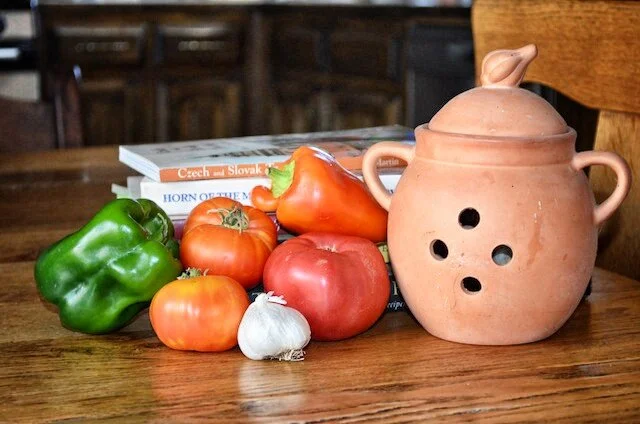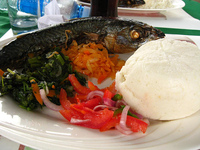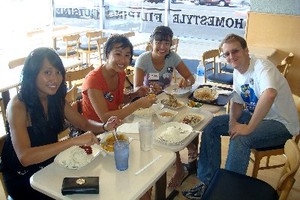When Keturah Kendrick returned to visit East Africa, she had a craving for goat brochettes at Le Poete. When she lived as an expat in Kigali, the capital of Rwanda, she’d been within walking distance of the restaurant and gorged herself on skewers of grilled goat several times a week. On this visit, however, satisfying the craving proved to be an adventure of its own.
All tagged Food
Food Sharing, Barcelona Style
Some people love to share their food. Kristine Mietzner, not so much. Then a Barcelona food tour changed everything.
Shanghai Hairy Crabs
Erin Mooz flew halfway across the world to visit her college roommate’s hometown, Shanghai, during Hairy Crab season, one of the city’s most anticipated culinary events of the year, and discovered there was more to the tradition than the delicious crustaceans.
A Foodie's Iran: 2 Authentic Recipes You Can Make Right Now
by Paul Ross
Warned not to go, I followed my appetite to Iran and have returned home filled with beautiful memories, blessed with new friends, and brimming with the desire to show and tell, taste and smell, and surprise all those who never expected to see me again.
A Partner Post by PerpetualExplorer.com contributor, Emma Corcoran.
Two or three times a week, Jay Savsani hosts a meal on the rooftop of his Chicago apartment complex. Last week his dinner guests were two Swiss tourists, and this week he’ll be hosting some fellow Chicagoans. Jay and his fellow diners are strangers but have connected through MealSharing.com, the food-centered social networking site Jay founded last year.
MealSharing allows diners and hosts from around the world to meet and share a home-cooked meal. Hosts put a profile on the site, which lists the types of food they usually cook and displays photos of their past culinary creations. Guests can then make contact and request a meal. MealSharing is a free platform; it costs nothing to participate as a guest or a host in this “couchsurfing for foodies” social movement.
“We come from a mission where we care about bringing communities together; be it from an international standpoint or within the local area,” says Jay, who says that “MealSharing is platform that connects travelers; however people also use it as a way to eat with other meal-sharers in their hometown.”
by B.J. Stolbov
It was a dark and cool morning. I was up before dawn. Quietly, I put on my boots and my hat. Then, accompanied by my protective guard dogs, Julius and Brutus, and my intrepid, knife-wielding guide, Samuel, we started out into the jungle in search of the elusive wild banana blossom.
The hills rolled away like brown buffaloes. Sighing as if still asleep, the trees drooped in the morning stillness. Birds flittered from tree to tree. Except for the sound of the distant chickens, a sound as pervasive as breathing itself, it was unusually quiet. The morning was calm. Not a breath of air moved. The dew was still thick on the tall grass. My view, from close to far, was green, jungle green, dark green, light green, middle green, green and green, everything was green. And I was searching for anything that wasn’t green. I was looking for yellow bananas and below that the most colorful plant in the jungle, the rare wild banana blossom. A banana blossom is a beautiful specimen. It is a deep reddish-purple and shaped like a huge upside-down rosebud.
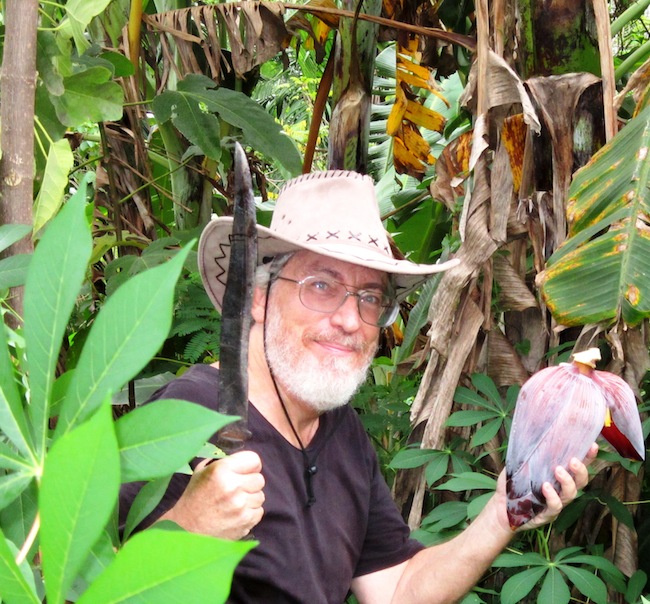
Bananas, in the wild, come in many varieties, shapes, sizes, and colors. The Saba is a thick banana. It is much like the plantain in the supermarket that everyone looks at but no one seems to know what to do with. The Saba is used for boiling into soups and stews, or just boiled, peeled, and eaten cold much like a potato. It is also boiled in sugar water to make a delicious dessert called banana glaze. It can also be deep-fried and rolled in sugar to make banana-que. Lakatan and Latundans are both sweet, eating banana, with the Lakatan being the sweetest-tasting banana I have ever eaten, especially when it is freshly picked. Empress bananas are the tiniest bananas, about the size of the palm of your hand and can be eaten in about two or three tasty bites. The long, yellow, perfect banana that you see in the supermarket is called a Cavendish. It is probably originally from near here. But your perfect banana, domesticated and grown on enormous plantations throughout the tropics, is no longer a wild banana.
The Quest for La Baguette
Ahh, la baguette, quintessentially French. Biting into your favourite baguette is a soothing affair that will bring a smile of contentment to your face. When you find a good one, all others pale in comparison. Every time my feet land on French soil, I start anticipating my first tasty baguette that will welcome me back to my second home. But it has to be the right baguette. Just as not all French wine is worth drinking, not all baguettes are worth consuming.

Crusty on the outside and hole-y on the inside, the perfect baguette is not too chewy, but rather soft with small bits of bread that ball up in your mouth as you chew. It can be slightly tangy and definitely has a distinct aroma. And baguettes are serious business in France with the average person consuming half a loaf per day. Precise laws protect this French institution with strict regulations concerning the ingredients; any kind of additives are an absolute faux pas. Flour, yeast, water and salt are all that is needed. A light dusting of flour on the outside, and 20 minutes later, voilà, your baguette is ready to devour.
As serious baguette lovers, I knew my daughters and I would have our work cut out for us when we moved to Paris. With over 1800 boulangeries in the capital and 12 within a 10-minute walking distance of our new apartment, some taste-testing would definitely be involved. As soon as we dropped our suitcases in our new Parisian flat, we happily took on this challenge. I felt like Goldilocks of the three bears fame—I knew it would take several attempts until we got it "just right."
I am sure you’ve heard that Spanish food is incredible, that it’s unlike anything you’ve ever tasted, that it’s innovative and bright and well, you know – all that hype. Here’s the thing. It’s totally true. Unfortunately, it took me a good two years of living in Spain to realize it.
Let me back up a bit. I moved to Spain on the premise of staying for nine months – just enough time to explore Europe and sink my teeth into Spain before heading back home. My first day in Spain, I was all alone. I hadn’t made friends yet, but that clearly had no effect on my hunger, and I walked into a little bar to order a sandwich. Now a sandwich in the United States is a hefty sort of thing, layered with ingredients and toppings and sauces. And as I was fairly hungry when I ordered this “sandwich,” I was more than disappointed when two flimsy toasted pieces of sandwich bread came my way with a little lettuce, tomato and a fried egg stuffed between them.
Okay, so my first experience wasn’t great, but over time I did learn to enjoy Spanish food. I liked it. I really liked it. But I never reached the point of loving it. I continued ordering the same things again and again at restaurants and bars, and never felt it was special. In my head, American food was superior to the simple and often bland food of Spain.
About a year and a half after I moved to Spain, I met my Spanish boyfriend, and I decided to tell him my opinion about all of this. He was shocked. I thought he was too proud to admit I was right, but I realize now I was horribly mistaken. As we continued dating, I started tasting foods I had never even heard of before, and I had to come to terms with the fact that after eighteen months of eating three meals a day, I actually knew nothing about Spanish food. Actually, my realization was an epiphany.
Adventures of a Cookbook Traveler
by Dorty Nowak
I collect cookbooks the way others collect travel books. More than souvenirs of places I have been, they help me recreate memories and whet my appetite for further trips. Over the years, I’ve accumulated an impressive library, with Europe, Asia and the Americas grouped together on my bookshelf. When I open Provence, the Beautiful Cookbook, and look at a picture of glossy tomatoes clustered with deep green zucchinis, papery garlic, and branches of rosemary I can taste the wonderful ratatouille I had in Nice, and I’m there once again.
I developed a taste for culinary travel early. My mother, who hated to cook, had a limited repertoire, which reflected her German-Irish roots. Meat, potatoes and vegetables cooked to a uniform grey were standard fare and I could usually predict what we would have for dinner by the day of the week. The Joy of Cooking was the mainstay of her library. It was, and is, a no-nonsense compendium of recipes, with no pictures to grace its pages. When I was fortunate to travel to Europe in college, the pleasure of sampling new foods and the beautifully illustrated cookbooks I collected were almost as exciting as touring the sights.
by Ellen Barone
[this is the final article in our SPOTLIGHT ON PORTUGAL series this week... ]
When the only vices of a place involve food and wine, booking a flight is a no-brainer according to my travel rules. Throw in sandy beaches, cultural riches, mild climate, a lost-in-time pace of life, and an inexpensive cost of living, and you won me over, Portugal.
On a recent visit to the northern wine country, I spent four delicious days table-hopping from hearty lunches, rustic meals featuring unpretentious fare and artisanal feasts prepared by innovative young chefs who bring a creative flare to traditional specialties. Each meal was paired with the region’s fresh, light, aromatic wines known collectively as Vinho Verdes.
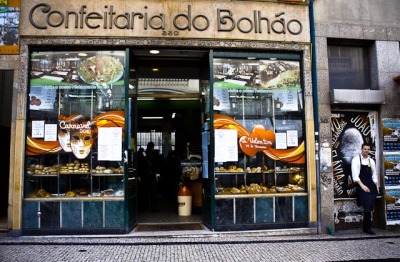 In Porto, the Confeitaria do Bolháo (Rua Formosa 339) proves it doesn’t have to be expensive to be good. I’d wandered into the café for an espresso and to sit out an afternoon rain shower. But I quickly upgraded my order to the meal of choice among the elderly patrons in wool caps and sturdy shoes who packed the place. “Yes, it’s fantastic”, said the waiter, when I asked to have what the couple at the table beside me were so obviously enjoying – a plentiful plate of crispy sardines, crusty bread, a delicious stew of red beans and rice and a carafe of robust red wine. Total bill: 7-euros. Nice.
In Porto, the Confeitaria do Bolháo (Rua Formosa 339) proves it doesn’t have to be expensive to be good. I’d wandered into the café for an espresso and to sit out an afternoon rain shower. But I quickly upgraded my order to the meal of choice among the elderly patrons in wool caps and sturdy shoes who packed the place. “Yes, it’s fantastic”, said the waiter, when I asked to have what the couple at the table beside me were so obviously enjoying – a plentiful plate of crispy sardines, crusty bread, a delicious stew of red beans and rice and a carafe of robust red wine. Total bill: 7-euros. Nice.
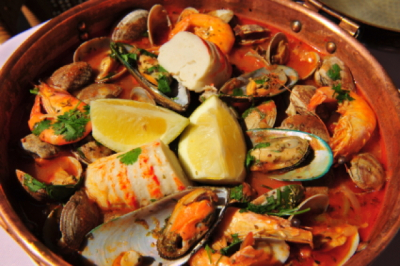 A perfect example of the region’s rustic fare is Restaurante Páteo das Figueiras (Rua do Além 257), a homey establishment near Braga which serves exquisite local cuisine family-style in a simple and cozy room. The caldierada, a stew consisting of a variety of fish and shellfish with potatoes, tomato and onion, scooped up with a garlicky bread, was delicious.
A perfect example of the region’s rustic fare is Restaurante Páteo das Figueiras (Rua do Além 257), a homey establishment near Braga which serves exquisite local cuisine family-style in a simple and cozy room. The caldierada, a stew consisting of a variety of fish and shellfish with potatoes, tomato and onion, scooped up with a garlicky bread, was delicious.
Drop me down in a coffeehouse somewhere in the world, and if I have ever visited that country the native rituals will tell me where I am before I’ve heard a single “sucre”, “glyko”, “milchcafe”, or “café negro.”
 flickr photo by uteart via flickr (common license)In Europe and the Americas, coffee is the upstart, edging out the earlier communal drinks of hot chocolate and hot tea. I have learned from impeccable sources that coffee was first discovered by goats. That legend somehow makes me feel better about the fact that although I love coffee houses and their ritual, I really can’t stand coffee. With a few slight exceptions, I drink tea—or hot chocolate.
flickr photo by uteart via flickr (common license)In Europe and the Americas, coffee is the upstart, edging out the earlier communal drinks of hot chocolate and hot tea. I have learned from impeccable sources that coffee was first discovered by goats. That legend somehow makes me feel better about the fact that although I love coffee houses and their ritual, I really can’t stand coffee. With a few slight exceptions, I drink tea—or hot chocolate.
In Greece, my husband and I acquired a taste for Greek coffee, in defense against the alternative to American coffee. The waiter inevitably served a small shiny packet of powdery brown stuff, which would perhaps dissolve if the water in the cup were hot enough. From the prevalence of this powdery stuff throughout southern Europe, we figured that some Swiss Nescafé guy was one heck of a salesman.
To ease into drinking Greek coffee, served in a small cup that holds strong black liquid on top of a spoonful of black sludge, and makes you grateful it comes in a tiny cup, we took it sweet. This coffee, we decided, explains the hairy chests on Greek fishermen. It helps to drink it down after a glass (or between glasses) of ouzo, the licorice-flavored, clear firewater of Greece. While ouzo is getting you drunk, the strong coffee is sobering you up. I could keep that routine going for quite a while.
I had first discovered that trick in Switzerland, where I found I could indeed tolerate a cup of coffee livened with a lot of plumkirsche or orange or pear-flavored liquer, or best of all, cheri-suise. Yum!
I am not one of those Americans for whom a familiar breakfast serves as a security blanket. You know what I mean. “I must have fresh ground coffee.” “I have to start the day with a three-minute egg. Don’t those people have an egg timer?”
I welcome that plunge into local culture, as, not quite full conscious, I am confronted with something on a plate or in a bowl that seems, well, foreign.
How to Eat Breakfast around the World
1. New Zealand
Baked beans. Okay, get over it. Beans are a good source of protein, have a touch of sweetness, and the fiber equivalent of stewed prunes. The milk for your tea will be down the hall in the hotel in a small fridge.
2. Austria
Loosen your belt. Several times a day, stop in a café for Austria’s favorite sport—piling schlag (whipped cream) on coffee mit chocolate mit maybe a slurp of rum. But that is not for breakfast. At breakfast time, stack your plate from the tidy buffet with meats, pink and brown rounds, cubes, rectangular slices marbled with white. Beside the meat, platters with neatly arranged stacks of cheeses—hard, soft, pale yellow to pumpkin orange, and hard boiled eggs in egg cups. Appel strudel and amazing breads. Try the sour pickles—honestly they go well with the meat. Be sure to walk a lot between castles and churches.
3. Switzerland
Same as Austria, but with more cheese. Stuff your pockets with Gruyere and break it out for lunch on a mountainside overlooking a lake.
4. Ireland
Ireland cooks up the kind of breakfast that leaves you in a stupor. Three kinds of meat and four kinds of bread (including Irish soda bread and heavy country wheat bread) and butter so good it makes you wonder if calling that yellow stuff wrapped in foil that you eat at home should be prosecuted for false labeling. Pile on some fried potatoes, some eggs, and take a nap before lunch. Only a few cups of strong Irish tea will keep you alert.
When I think of Filipino restaurants, I think of Sunday brunch after mass, the drive to the other side of Union City after what felt like a long hour on a church pew, and the joy I felt when my parents let my sister and I choose our favorite dishes from the steam table at our neighborhood Filipino restaurant.
I remember the fluorescent lights and tacky mirrored walls, the one-room family restaurant next to a liquor store and a crowded Asian supermarket with the special of the day hand-written on a piece of paper and taped to the wall. Behind the counter there was usually a woman speaking Tagalog who asked what I'd like to order. She got wide-eyed and incredulous after I explained to her in English that my parents spoke English at home and I only heard Tagalog when they fought. I felt a fleeting sense of shame before she handed me my turon (fried banana roll) wrapped in tin foil or kutsinta (brown rice cake) with a little tub of shredded coconut before I sat down on a vinyl covered chair and white veneer or Formica table.






